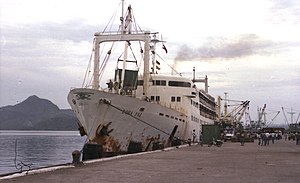MV Doña Paz

Doña Paz berthed at Tacloban City in 1984.
|
|
| History | |
|---|---|
|
|
|
| Name: |
|
| Owner: | RKK Line |
| Port of registry: |
|
| Builder: | Onomichi Dockyard |
| Yard number: | 118 |
| Launched: | 25 April 1963 |
| Fate: | Sold to Sulpicio Lines |
|
|
|
| Name: | Don Sulpicio |
| Owner: | Sulpicio Lines |
| Port of registry: |
|
| Route: | Tacloban-Catbalogan-Manila |
| Acquired: | 1975 |
| Renamed: | Doña Paz in 1981 |
| Refit: | After a fire onboard 5 June 1979 |
| Fate: | Caught fire and sank after a collision with the MT Vector on 20 December 1987. |
| General characteristics | |
| Class and type: | Passenger ferry |
| Tonnage: |
|
| Length: | 93.1 m (305 ft) |
| Beam: | 13.6 m (45 ft) |
| Speed: | 18 knots |
| Capacity: | 1,518 passengers |
| Crew: | 66 |
The MV Doña Paz was a Philippine-registered passenger ferry that sank after colliding with the oil tanker MT Vector on December 20, 1987. With an estimated death toll of 4,386 people and only 24 survivors, it was the deadliest peacetime maritime disaster in history.
Doña Paz was traveling from Leyte island to the Philippine capital of Manila. The vessel was seriously overcrowded, with at least 2000 passengers not listed on the manifest. In addition, it was claimed that the ship carried no radio and that the life-jackets were locked away. But official blame was directed at the MT Vector, which was found to be unseaworthy, and operating without a license, lookout or qualified master.
The Doña Paz was built in 1963 by Onomichi Zosen of Onomichi, Hiroshima, Japan, and was originally named Himeyuri Maru. During the time it travelled the Japanese waters, it had a passenger capacity of 608 people. In 1975, it was sold to Sulpicio Lines, a Filipino operator of a fleet of passenger ferries. It was renamed by Sulpicio Lines as the Don Sulpicio, and later, the Doña Paz.
On 5 June 1979, while named the Don Sulpicio, the vessel was gutted by fire while en route from Manila to Cebu. All 1,164 on board were rescued but the vessel was beached and declared a constructive total loss. The wreck was repurchased from the underwriters by Sulpicio Lines, and the vessel was refurbished and returned to service as the Doña Paz.
At the time of its sinking, the Doña Paz was sailing the route of Manila → Tacloban → Catbalogan → Manila and vice versa, making trips twice a week.
On December 20, 1987, at 06:30, Philippine Standard Time, the Doña Paz left from Tacloban City, Leyte, for the City of Manila, with a stopover at Catbalogan City, Samar. The vessel was due in Manila at 04:00 the following day, and it was reported that it last made radio contact at around 20:00. However, subsequent reports indicated that the Doña Paz had no radio. At around 22:30, Philippine Standard Time, the ferry was situated at Dumali Point, along the Tablas Strait, near Marinduque. A survivor later said that the weather at sea that night was clear, but the sea was choppy. While most of the passengers slept, the Doña Paz collided with MT Vector, an oil tanker en route from Bataan to Masbate. The Vector was carrying 8,800 US barrels (1,050,000 l; 280,000 US gal; 230,000 imp gal) of gasoline and other petroleum products owned by Caltex Philippines.
...
Wikipedia
